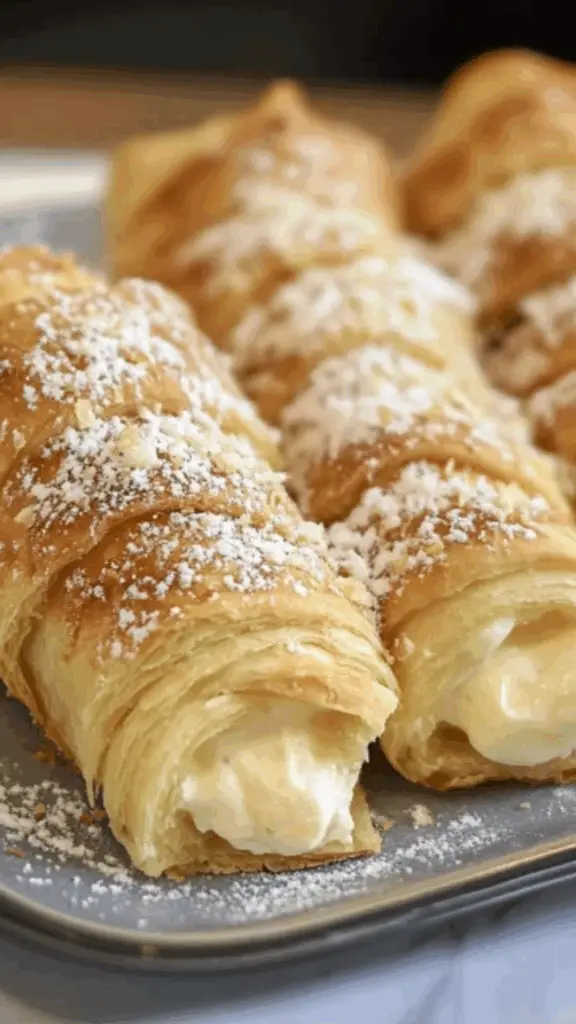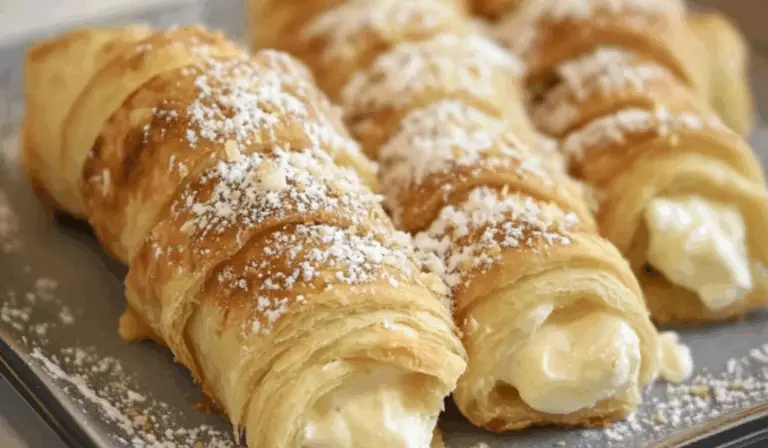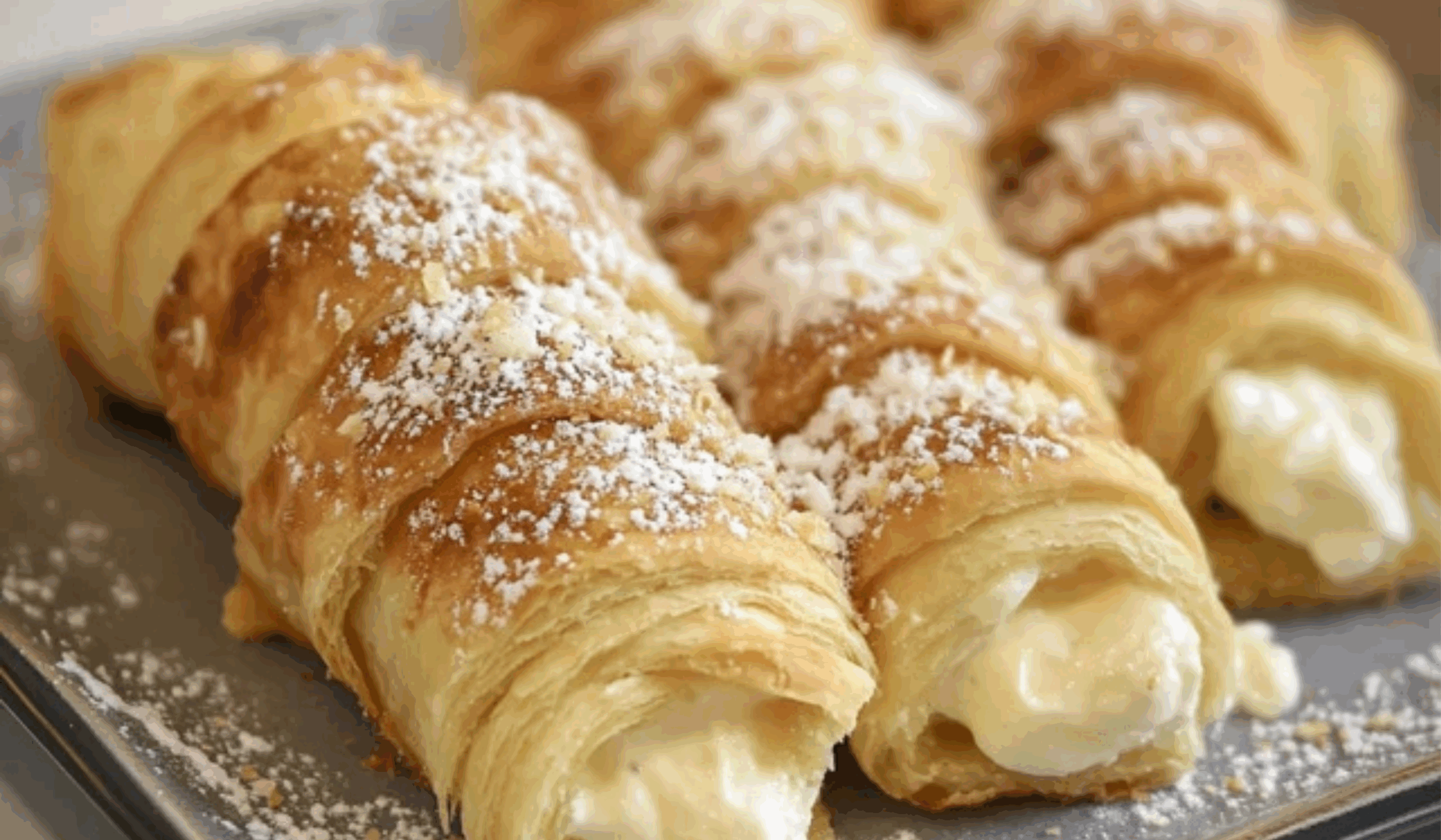Italian cuisine has long been celebrated for its timeless desserts, and few are as visually stunning and indulgently satisfying as cannoncini—better known in English as cream horns. These golden, crisp pastry shells are filled with luscious custard cream and dusted with a gentle snow of powdered sugar. Though they may look like something out of a professional pastry shop, this guide will show you how simple it can be to recreate them at home using store-bought puff pastry and a few everyday ingredients. Whether you’re preparing for a celebration or simply looking to treat yourself to an elegant dessert, these Italian cream horns promise to impress without overwhelming your kitchen skills.

Ingredients and Preparation
This recipe yields 12 cream horns. The components are straightforward, and most ingredients can be found in your pantry or local supermarket.
For the Custard Cream (Crema Pasticcera):
- 3 egg yolks
- 3 tablespoons (30 grams) all-purpose flour
- ½ cup (100 grams) granulated sugar
- 1 teaspoon vanilla extract
- 8 ounces (235 milliliters) whole milk
For the Pastry Horns:
- 1 sheet puff pastry, defrosted (about 8 ounces or 225 grams)
- ¼ cup (50 grams) granulated sugar
- 1 egg (for egg wash)
- 1 tablespoon water (for egg wash)
- Powdered sugar, for dusting
Equipment Needed:
- Conical horn molds (usually available online or at specialty baking stores)
- Rolling pin
- Baking sheet lined with parchment paper
- Piping bag for filling
- Small saucepan and whisk
Step-by-Step Instructions
- Prepare the Custard Cream
Begin by heating the milk in a small saucepan until hot, but not boiling. In a separate medium saucepan, whisk the egg yolks with sugar, vanilla extract, and flour until smooth and light. Gradually add the warm milk a little at a time while whisking continuously to avoid lumps. Place the saucepan over medium heat and stir constantly until the mixture reaches a gentle boil and thickens into a smooth custard. Lower the heat and cook for another minute or two until you achieve the desired consistency. Transfer the custard to a glass bowl, cover with plastic wrap (pressed directly onto the surface to prevent a skin from forming), and let cool. Once at room temperature, refrigerate for at least an hour. - Prepare the Puff Pastry
Preheat your oven to 400°F (200°C). Lightly flour your work surface and sprinkle some granulated sugar both under and over the puff pastry sheet. Roll it out gently to a rectangle about 9 by 12 inches. Using a sharp knife or pizza cutter, slice the pastry into 12 even strips, each about 1 inch wide. For consistency, first cut the sheet into three equal parts, then divide each into four strips. - Form the Horns
Wrap each strip of pastry around a conical horn mold, starting from the pointed end and overlapping slightly as you wind toward the wider end. Place each wrapped mold seam-side down on the parchment-lined baking sheet. In a small bowl, whisk the egg with a tablespoon of water to make an egg wash. Brush each pastry-wrapped mold lightly with the egg wash, avoiding the edges where the pastry meets the mold to ensure easy removal after baking. - Bake the Horns
Place the tray in the preheated oven and bake for 15 to 20 minutes, or until the horns are puffed and golden brown. Remove from the oven and allow them to cool slightly. Gently remove the molds by pressing them in slightly and twisting if necessary. If the pastry sticks, avoid forcing it out—let it cool a bit longer to ease removal. - Fill and Finish
Once the pastry shells are completely cool and the custard has chilled and thickened, transfer the cream to a piping bag. Fill each horn generously. Dust the finished horns with powdered sugar right before serving for a professional finish.
Beginner Tips and Notes
- Puff Pastry Handling: Ensure your puff pastry is fully thawed but still cold. If it becomes too warm, refrigerate it briefly before working with it again to keep the butter intact, which helps create that signature flakiness.
- Avoid Egg Wash Stickiness: Take care not to brush the egg wash too close to the seam or mold—it can act like glue and make the pastry stick when you try to remove it later.
- Prevent Lumpy Custard: Adding the warm milk slowly while whisking is key to a smooth custard. Constant stirring over gentle heat will prevent it from catching on the bottom of the pan.
- Chilling the Cream: The custard needs to cool completely before piping. A warm filling can melt the pastry or ooze out.
- Mold Alternatives: If you don’t have horn molds, some creative home bakers wrap puff pastry strips around foil-wrapped sugar cones or roll their own molds using thick parchment paper covered with foil.

Golden Italian Cream Horns: A Step-by-Step Guide to Classic Cannoncini
Crispy, creamy, and oh-so-dreamy! 🥐💫 These Golden Italian Cream Horns (Cannoncini) are a delicious combo of light puff pastry and velvety cream filling. 🇮🇹🍦 Whether you’re new to baking or looking to impress, this beginner-friendly guide walks you through every step. 🧁✨ A classic treat with bakery-worthy flavor, perfect for holidays, brunch, or anytime indulgence. Bite into one and taste a little piece of Italy at home! 😋🍮
- Total Time: 45 minutes
- Yield: 12 cream horns 1x
Ingredients
For the Custard Cream (Crema Pasticcera):
- 3 egg yolks
- 3 tablespoons (30 grams) all-purpose flour
- ½ cup (100 grams) granulated sugar
- 1 teaspoon vanilla extract
- 8 ounces (235 milliliters) whole milk
For the Pastry Horns:
- 1 sheet puff pastry, defrosted (about 8 ounces or 225 grams)
- ¼ cup (50 grams) granulated sugar
- 1 egg (for egg wash)
- 1 tablespoon water (for egg wash)
- Powdered sugar, for dusting
Equipment Needed:
- Conical horn molds (usually available online or at specialty baking stores)
- Rolling pin
- Baking sheet lined with parchment paper
- Piping bag for filling
- Small saucepan and whisk
Instructions
- Prepare the Custard Cream
Begin by heating the milk in a small saucepan until hot, but not boiling. In a separate medium saucepan, whisk the egg yolks with sugar, vanilla extract, and flour until smooth and light. Gradually add the warm milk a little at a time while whisking continuously to avoid lumps. Place the saucepan over medium heat and stir constantly until the mixture reaches a gentle boil and thickens into a smooth custard. Lower the heat and cook for another minute or two until you achieve the desired consistency. Transfer the custard to a glass bowl, cover with plastic wrap (pressed directly onto the surface to prevent a skin from forming), and let cool. Once at room temperature, refrigerate for at least an hour. - Prepare the Puff Pastry
Preheat your oven to 400°F (200°C). Lightly flour your work surface and sprinkle some granulated sugar both under and over the puff pastry sheet. Roll it out gently to a rectangle about 9 by 12 inches. Using a sharp knife or pizza cutter, slice the pastry into 12 even strips, each about 1 inch wide. For consistency, first cut the sheet into three equal parts, then divide each into four strips. - Form the Horns
Wrap each strip of pastry around a conical horn mold, starting from the pointed end and overlapping slightly as you wind toward the wider end. Place each wrapped mold seam-side down on the parchment-lined baking sheet. In a small bowl, whisk the egg with a tablespoon of water to make an egg wash. Brush each pastry-wrapped mold lightly with the egg wash, avoiding the edges where the pastry meets the mold to ensure easy removal after baking. - Bake the Horns
Place the tray in the preheated oven and bake for 15 to 20 minutes, or until the horns are puffed and golden brown. Remove from the oven and allow them to cool slightly. Gently remove the molds by pressing them in slightly and twisting if necessary. If the pastry sticks, avoid forcing it out—let it cool a bit longer to ease removal. - Fill and Finish
Once the pastry shells are completely cool and the custard has chilled and thickened, transfer the cream to a piping bag. Fill each horn generously. Dust the finished horns with powdered sugar right before serving for a professional finish.
Notes
- Puff Pastry Handling: Ensure your puff pastry is fully thawed but still cold. If it becomes too warm, refrigerate it briefly before working with it again to keep the butter intact, which helps create that signature flakiness.
- Avoid Egg Wash Stickiness: Take care not to brush the egg wash too close to the seam or mold—it can act like glue and make the pastry stick when you try to remove it later.
- Prevent Lumpy Custard: Adding the warm milk slowly while whisking is key to a smooth custard. Constant stirring over gentle heat will prevent it from catching on the bottom of the pan.
- Chilling the Cream: The custard needs to cool completely before piping. A warm filling can melt the pastry or ooze out.
- Mold Alternatives: If you don’t have horn molds, some creative home bakers wrap puff pastry strips around foil-wrapped sugar cones or roll their own molds using thick parchment paper covered with foil.
- Prep Time: 20 minutes
- Cook Time: 25 minutes
Serving Suggestions
These cream horns make a beautiful centerpiece for a dessert table or tea-time gathering. Serve them on a white porcelain tray or a rustic wooden board for a contrast of elegance and simplicity. Pair them with coffee, espresso, or dessert wine for an authentic Italian experience. Because the custard can soften the pastry over time, it’s best to fill the horns shortly before serving. If you’re preparing for an event, you can bake the shells ahead of time and store them unfilled in an airtight container.
For variety, serve alongside other Italian pastries like biscotti, amaretti cookies, or panna cotta. A few fresh berries or mint leaves on the side can brighten the presentation without competing with the flavor.
Engagement Features
Storage Advice:
Unfilled puff pastry shells can be stored in an airtight container at room temperature for up to two days. For longer storage, freeze them after baking (without cream) and reheat in a low oven before use. Filled cream horns should be eaten within 24 hours and kept refrigerated if not served immediately.
Flavor Variations:
While classic vanilla custard is traditional, feel free to experiment. Try a chocolate custard by adding cocoa powder during the cooking process, or incorporate citrus zest for a fresher twist. You can even fold in a bit of whipped cream to lighten the texture for summer servings.
Common Reader Questions:
Can I use phyllo dough instead of puff pastry?
Phyllo dough creates a much crispier, more fragile shell and requires brushing each layer with butter. It’s not a direct substitute but can work if you’re looking for a lighter crunch.
Can I use dairy-free alternatives?
Yes. Almond or coconut milk can be used for the custard, though it may affect flavor and texture slightly. Coconut milk tends to yield a creamier result than almond.
Do I need to refrigerate leftovers?
Yes, once filled with cream, leftovers should be refrigerated and consumed within a day to maintain freshness.
Is there a savory version of these horns?
Absolutely. The same pastry shells can be filled with savory fillings like herbed cream cheese, chicken salad, or beef mousse for a different take on appetizers.

